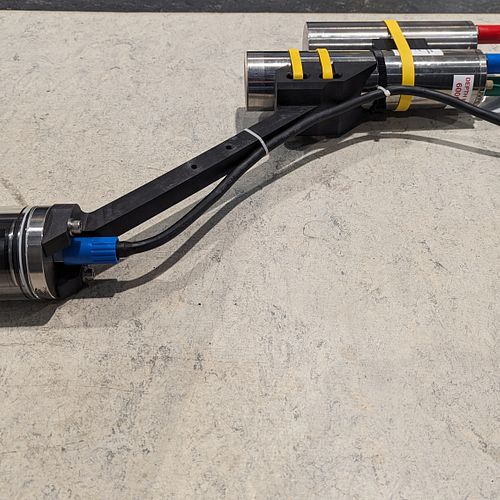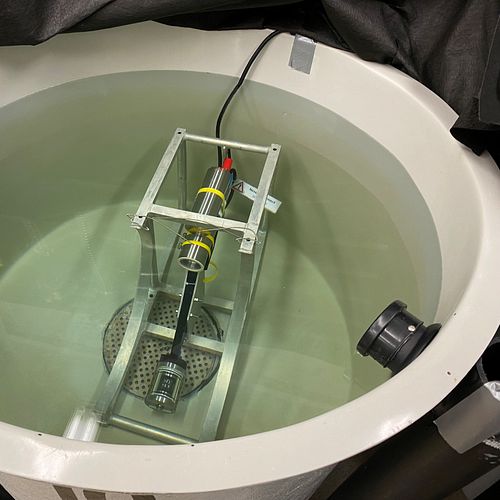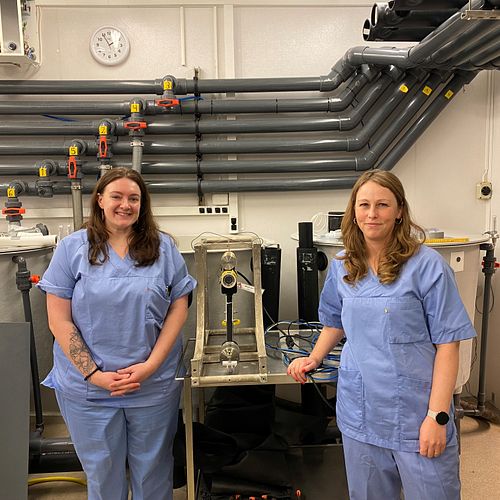29 November 2023 news
In the project "Real-time detection of free-swimming sea lice larvae" (e-Lice), Akvaplan-niva and partners utilize advanced sensors and AI to detect and quantify salmon lice in the water column. In October was the start of the first experiment in the project, testing the underwater imager UVP6, and developing an algorithm to classify the lice.

The underwater vison profiler, UVP6 (Photo: Trude Borch/Akvaplan-niva).
Ragnhild Pettersen from Akvaplan-niva installed an Underwater vision profiler (UVP6) imager produced by Hydroptics in a 430-liter test-tank at VESO Aqualab. Adult salmon lice females with egg strings had been collected the week prior from a salmon slaughterhouse and were hatched in the laboratory at VESO Aqualab.

Tank setup (Photo: Ragnhild Pettersen).
The first day, salmon lice in the nauplius stage (0.5-0.7 mm) were added to the test tank in a high concentration The lice were kept in the tank so that the nauplius initially added molted into their next developmental stage – copepodites while being in the test tank- this usually takes about 3 days at 12o C. On day 3 all the lice in the hatchery were added to the tank to increase the density of lice passing by the imager sensor. From this day on, lice in the tank were a mixture og nauplius and copepodites where all the nauplius after some days were molted into copepodites. The UVP6 was left in the tank for 15 days with continuous imaging producing thousands of images which are needed for developing the algorithm that will be used to classify the lice.

Lice density (Photo: Ragnhild Pettersen

Lice entering the tank (Photo: Ragnhild Pettersen)

Lice in the tank (Photo: Ragnhild Pettersen)
The objects imaged by the UVP6 can be biotic (zooplankton and fish larvae) or abiotic (particles) in nature. Given the diversity of particles (e.g., detritus) and other co-occurring zooplankton in the water, it is important that free-swimming stages of salmon lice are detected and classified correctly. To meet this challenge, we developed Artificial Intelligence and Computer Vision based algorithms to automatically detect and classify the objects imaged by the UVP6 in real-time. The algorithms used in this regard come in two tiers: (i) classic machine learning based image algorithm for embedded, real-time object classification and (ii) state-of-the-art deep learning algorithms to validate the classifications of the embedded classifier. The machine learning algorithm is based on an existing model designed specifically to work with the UVP6 (https://github.com/ecotaxa/uvpec). Based on our tests, our algorithm is able to detect and classify salmon lice with >91% accuracy.
The next step of the project will be to implement the UVP6 in a mooring that will be deployed and tested in the field in Tromsø early 2024 before it is deployed in a strategic location to detect and quantify free swimming salmon lice in a Norwegian fjord.

Mooring system with the UVP6 to be deployed and field tested.
This project is financed by FHF-Norwegian Seafood Research Fund and led by Akvaplan-niva. Project partners are VESO, Nova Sea, Kongsberg Discovery, Hydroptic and MP Consulting.
More about the project here: https://akvaplan.no/en/project/e-lice (project webpage in Norwegian only).








